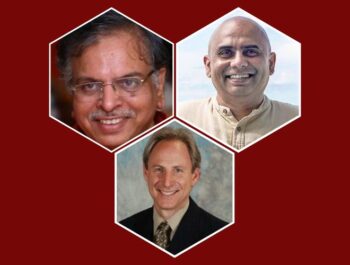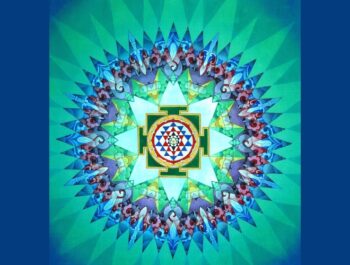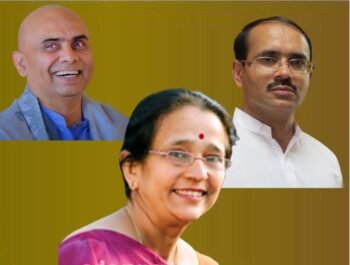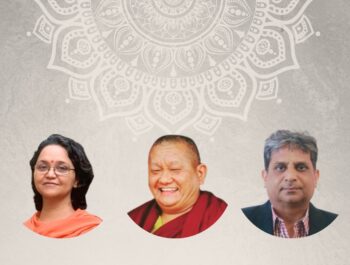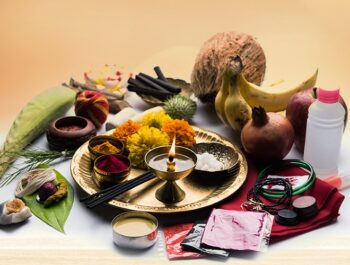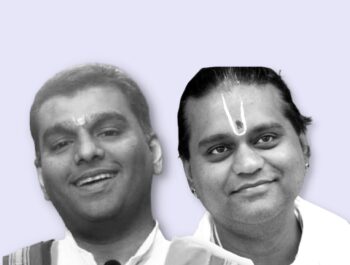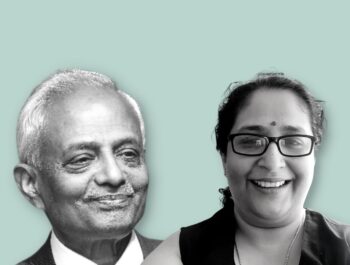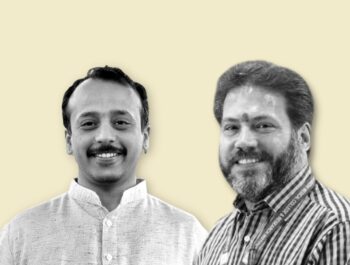Center for Soft Power has scheduled a series of talks on the “Study of Travel of Ideas” to explore how knowledge has travelled from India to the world, how it transformed and its nature today. We wish to start with Ayurveda, which has many practitioners today all over the world practicing it and offering its benefits to all who believe in its value systems. The topic is “The Indian Medicine Trade Route”.
Events Platfrom: Softpower
TATWA TANTU
THE SACRED THREAD OF REALITY
A 6-Day Retreat @Vaidyagrama Ayurveda Healing Village
A 6-day retreat that educates, nurtures and rejuvenates you through the doorway of the senses leading to seeing our interconnectedness with the Pancha Bhutas.
The retreat will be in the Sylvan campus of Vaidyagram, where peacocks roam and trees sway to a gentle breeze. Experience classical Ayurveda with a host of doctors and staff whose care and gentleness are a salve for the stressed person. A retreat that will rejuvenate your sense organs. We see the thread of Reality interwoven through the sacred knowledge of Temples, Vedanga Vaastu, Sangeetam, Nrityam, Shilpa Sastra, Ayurveda, Vedanga Jyotisha and Vedanta with a host of renowned Gurus, Scholars and Artists.
Scope to learn the how of making kumkum, Vibhuti, Kolam, weaving flowers, making clay Ganeshas, listening to stories of temples, listening to soul-stirring music and rhythm.
SCHEDULE
| Date | Name | Topic |
| 09-Mar-24 | Mr Aditya Mazumdar | Orientation |
| 09-Mar-24 | Ms Vijayalakshmi Vijayakumar | Introductory Talk |
| 09-Mar-24 | Ms Meera Natampally |
Temples Explained
|
| 10-Mar-24 | Swami Gurupriyananda |
Dhanwantari Homam and Abhishekam
|
| 10-Mar-24 | Dr Vinayachandra | Indica Yoga |
| 10-Mar-24 | Dr Deepa Duraiswamy |
Agamas, Temples, Pancha Bhutas
|
| 10-Mar-24 | Dr M V Vishwanath |
Temples, Aakasa Tatwa, Vaastu
|
| 10-Mar-24 | Mr Rajeev |
Sound/ Hearing
|
| 10-Mar-24 | Mr Rajeev |
Temple, Raaga, Rhythm
|
| 11-Mar-24 |
Swami Gurupriyananda
|
Dhanwantari Homam and Abhishekam |
| 11-Mar-24 | Dr Vinayachandra | Indica Yoga |
| 11-Mar-24 | Dr Rangan Ramakrishnan |
Sruthi Sravaka, Aakasa and Vaayu Tatwa
|
| 11-Mar-24 | Dr Vijayalakshmi Subramaniam |
Temples, Vaayu Tatwa, Music, Praana
|
| 11-Mar-24 | Ms Simran Lal | Touch/ Feeling |
| 11-Mar-24 | Mr Rajeev |
Temples, Raaga and Rhythm
|
| 12-Mar-24 | Swami Gurupriyananda | Dhanwantari Homam and Abhishekam |
| 12-Mar-24 | Dr Vinayachandra | Indica Yoga |
| 12-Mar-24 | Swamini Brahmaprajnananda |
Thread of reality interwoven through the
sacred knowledge of Pancha bhutas |
| 12-Mar-24 | Dr Padma Subrahmanyam Ms Rukmini Vijayakumar |
Temples, Agni Tatwa, Dance, Visual Arts
|
| 12-Mar-24 | Vaidyas of Vaidyagrama | Vision/seeing |
| 12-Mar-24 | Mr Rajeev | Raaga and Rhythm |
| 13-Mar-24 | Swami Gurupriyananda | Dhanwantari Homam and Abhishekam |
| 13-Mar-24 | Dr Vinayachandra | Indica Yoga |
| 13-Mar-24 | Swamini Brahmaprajnananda |
Thread of reality interwoven through the
sacred knowledge of Pancha bhutas |
| 13-Mar-24 | Dr Ramkumar |
Temples, Aapah Tatwas, Ayurveda
|
| 13-Mar-24 | Mr Rajeev Temple |
Raaga and Rhythm
|
| Swami Gurupriyananda | Dhanwantari Homam and Abhishekam | |
| 14-Mar-24 | Dr Vinayachandra | Indica Yoga |
| 14-Mar-24 | Swami Brahmaprajnananda |
Thread of reality interwoven through the
sacred knowledge of Pancha bhutas |
| 14-Mar-24 | Mr Shirdi Nath Tekur |
Temples, Bhu Tatwa, Jyotisha
|
| 14-Mar-24 | Ms Hemavathi & Mr Darshan | Smell/Olfactory Senses and Perfumery |
| 14-Mar-24 | Mr Rajeev |
Temple – Raaga and Rhythm
|
Please join us for a Series of Webinars on “Srishti-Sthiti-Laya” jointly brought to you by INDICA and Heritage.
This is the 3rd in this Series where an Eminent Panel of three is in a discussion on “Srishti-Sthiti-Laya” from the “Perspective from Ayurveda and Genetics”.
This Series of Talks is a run up to “GUDIYA SAMBHRAMA – THE TEMPLE FESTIVAL 2024”
Brahma, Vishnu, Maheshwara – the Trimurti in Sanatana Dharma and the Tridevi– Saraswathi, Lakshmi and Parvathi are ever present performing their divine functions – Srishti (creation), Sthiti (preservation) and Laya (dissolution). The three aspects guide the bhakta’s expression of devotion and the expression of that devotion in the arts.
According to Advaita Vedanta, there is a beginning-less and endless cycle of creation, maintenance and dissolution or resolution, called ‘srishti’, ‘sthiti’, and ‘laya’. This is indeed fascinating as it strongly complies with the concept of matter converting into energy and back.
Energy converting into matter is called srishti. In each srishti, or creation, the variety and pattern of objects, the attributes of the bodies and minds and the events and situations have to be fashioned to suit the energy it carries. This is also related to the concept of karma.
Matter in various modes of motion is sthiti. This is the mode of existence that human beings normally refer to. This is the stage of maintenance.
The third stage of this cycle is laya or the stage of resolution. Laya is matter converting into energy. This conversion can be at any level. In-fact, on a large-scale, laya can even attain the form of ‘pralaya’.
Pralaya, often misunderstood as Dooms-Day, is anything but that. It is a part of a never-ending cycle of creation (srishti), maintenance (sthiti) and resolution (laya), which is endless and has no beginning either.
An influential thinker from the 20th century stated that culture cannot be abridged to only its tangible products, because culture is continuously evolving and constantly evolving. According to the international community, the main attributes of a culture were limited to tangible cultural expressions, and their significance was evaluated on the basis of their artistic, aesthetic, architectural, visual, scientific, and economic value.
However, the essence of intangible elements in a culture cannot be overlooked, because these elements can be employed to accomplish the task of transferring knowledge, to the next of kin, of preservation of their own culture. Experts were of the view that in this era with a rich cultural variety of humanity moving towards uniformity. This can be dangerous because uniformity can lead to disintegration of cultural heritage.
But, Bharata is a land that includes thousands of living traditions, with each community striving hard to preserve their heritage. These include Kumbh Mela, Mysore Dasara, Karagam, Durga Puja, chanting and more.
CSP celebrates heritage week from the 19th to 25th November, and on the culminating day, we celebrate the intangible heritage of chanting with a Vedic and Buddhist scholar. Both Vedic and Buddhist chanting of Ladakh were recognised by UNESCO and added to the Representative List of the Intangible Cultural Heritage of Humanity.
Join us on November 25th, at 7PM IST, as we explore and celebrate the heritage of chanting.
We will hear from experts on the importance of chanting in both Vedic and Buddhist traditions.

Sugandha, Surabhi, Parimala, Aamoda are just a few of the numerous Sanskrit words for fragrance, with fragrance occupying significant place right from the Veda mantras through Itihasas, Puranas and Aagamas to ancient Sanskrit poetic works. In the famous and popular Rig Veda mantra “oṃ tryámbakaṃ yajāmahe sugandhíṃ puṣṭi-vardhánam urvārukam íva bandhánān mṛtyor mukṣīya mā ‘mṛtā́t” among the two qualities of tryambaka, the first mentioned is Sugandhi = the fragrant one.
The Yajnas were known for their diffusion of fragrance from the material offered into the fire as offerings to various Devatas. Hindu temple and household worship rituals are characterized by the offerings of the fragrant material through dhoopa, aarati, teertha and prasaada. Ayurveda devotes a significant portion of its wellness system to Aroma therapy outlining the details of different kinds of aromas that can heal various ailments. The Brihat Samhita has chapters on fragrance, Gandhayukti. Indian culinary science always incorporated Sugandha dravyas, i.e., spices in a big way giving Indian cuisine its characteristic flavor. More significantly, it is the Indian spice trade that contributed to the economy during ancient and medieval times compelling Europeans to find sea routes to India. There are detailed descriptions of how herbal powders and pastes were intensely used in the personal daily embellishment of Indians, particularly women. Aphrodisiac effects of fragrance are so well incorporated into the Hindu imagination/mind that Manmatha, the god of eros is viewed as flower-arrowed. In all the rituals and cultural traditions of all the components /strands of the Hindu cultural complex like Vaidika, Jaanapada (folk), Aaranya/ Paarvata(tribal), the fragrant material plays a vital role through their psychosomatic and magical/ supernatural effects.
The symposium is being organised in collaboration with Vigirom Pvt Ltd ( VPL) Bengaluru. VPL was established by Late Sri K. Vijayakumar, a veteran of the Indian Perfume Industry. Sri K. Vijaykumar who studied in the School of Perfumery, France was also well versed in the use of fragrances and flavours in the Indian ethos. He was very keen on exploring this topic as it has not received due attention from the scholars. INDICA is now pleased to collaborate with Vigirom in organising this event and bringing his desire to fruition. The event will be held on 29th October.
:::SCHEDULE:::
| 3.00 – 3.10 | Welcome | Shri Hari Kiran Founder, Indic Academy |
| 3.11 – 3.15 | Opening Remarks and Intro to Keynote speaker | Smt Vijayalakshmi Vijayakumar Co-founder – Director, Centre for Soft Power (CSP) |
| 3.15 – 3.45 | Keynote Address | Mr. Maurizio Volpi, President, Fragrance & Beauty Givaudan International, Switzerland |
| 3.50 – 3.53 | VoT & Introduction to the panel – Fragrance in folk traditions | Prof Nagaraj Paturi Director, Indic Academy |
| 3.53 – 3.55 | Introduction to the panelist | Varsha V Research Associate, CSP |
| 3.55 – 4.15 | Fragrance in Folk Traditions | Dr. Janardhan Ghosh, Performing Artist, Academic, Theatre Artist & Storyteller |
| 4.15 – 4.25 | Q&A | |
| 4.26 – 4.33 | VoT & Introduction to the panel – Fragrance, an Integral Aspect of Worship: | Prof Nagaraj Paturi |
| 4.33 – 4.35 | Introduction to the panelists | Varsha V |
| 4.35 – 4.55 | Fragrance, an Integral Aspect of Worship: Paancharatra | Shri MA Madhusudhanan, Vaishnavite Scholar |
| 4.56 – 5.15 | Fragrance, an Integral Aspect of Worship: Shaiva | Dr. T. S. Shanmukha Sivacharya, Acharya, Sri Kalikambal Temple, Chennai |
| 5.15 – 5.25 | Q&A | |
| 5.26 – 5.33 | VoT & Introduction to the panel – Fragrance in Sanskrit Literature | Prof Nagaraj Paturi |
| 5.33 – 5.35 | Introduction to Panelist | Varsha V |
| 5.35 – 5.55 | Fragrance in Sanskrit Literature | Dr. M.A Alwar Professor at Maharaja Sanskrit College, Mysore |
| 5.55 – 6.05 | Q&A | |
| 6.06 – 6.13 | Introduction to Panel – Aroma and Ayurveda | Smt Vijayalakshmi Vijayakumar |
| 6.13 – 6.15 | Introduction to Panelist | Varsha V |
| 6.15 – 6.35 | Aroma and Ayurveda | Dr. Somit Kumar Ghosh Director, Arya Vaidya Pharmacy, Coimbatore |
| 6.35 – 6.45 | Q&A | |
| 6.46- 6.53 | VoT & Introduction to the panel – Incense Industry and Indigenous Fragrances | Smt Vijayalakshmi Vijayakumar |
| 6.53 – 6.55 | Introduction to the panelists | Varsha V |
| 6.55 – 7.15 | Incense Industry and Indigenous Fragrances | Shri Arjun Ranga Managing Director, N Ranga Rao and Sons Pvt. Ltd. |
| 7.16 – 7.35 | Shri Yogesh Dubey President, Rakesh Sandal Industries | |
| 7.35 – 7.45 | Q&A | |
| 7.46 – 7.53 | VoT & Introduction to the panel – Flavours and Fragrance in Culinary Traditions | Smt Vijayalakshmi Vijayakumar |
| 7.53 – 7.55 | Introduction to Panelist | Varsha V |
| 7.55 – 8.15 | Flavours and Fragrance in Culinary Traditions | Smt Ammini Ramachandran Founder, Writer, and Editor of peppertrail.com |
| 8.25 – 8.30 | VoT & Introduction to Mr Michael Carlos | Smt Vijayalakshmi Vijayakumar |
| 8.30 – 8.50 | Valedictory Address | Mr. Michael Carlos Board of Directors, Givaudan |
| 8.50 – 8.55 | Vote of Thanks | Prof Nagaraj Paturi |
Prana in Sanskrit is used to describe the life giving force behind all of creation. It is this cosmic life-force that orbits the planets around the sun, expands and contracts the universe, fluctuates our social and ecological systems, ebbs and flows the tides of the ocean, and pulses the beat of our hearts. In essence, prana is the “cosmic breath” that moves in and out of our bodies to sustain our very existence. Many aspects of life get in our way, and hence the most important aspect gets sidelined- breathing. How we breathe can have such a powerful effect on our well-being.
Join Dr R Rangan ji and Dr A Subramanian on 22nd April, 2022 at 6.30 PM IST where he elucidates on the power breath has on our life.
Being fit is the new mantra. Workouts cause physical exertion, but when one pays attention to the rate, quality, and control of your breathing in your training, better results are achieved. Each time you inhale, oxygen is taken up, which is required for proper functioning of the body. The more one moves around, the need for oxygen goes up. Modern fitness enthusiasts speak of diaphragm breathing. Pranayama has always advocated diaphragm breathing for centuries. The main yogic breath to use throughout your practice is the diaphragmatic breath, also known as abdominal breathing. It requires less effort and energy while reducing stress and anxiety and improving overall health and wellness. The deep and side-core abdominal muscles are activated to stabilise your pelvis, spine and posture. Actively engaging the diaphragm improves lung capacity, volume and efficiency.
Join Dr W Selvamurthy and Dr Deepa Prakash on 20th April, 2022 at 6.30 PM IST where they will speak to us about the importance of breathing for fitness and proper cardiovascular processes.
Pranayama has been identified as a method of sadhana to trace life energy to its source, and find the root of all creation, in the micro and macro cosmos. However, the complexities of pranayama are difficult for all to grasp. However, the essence of pranayama and it’s source ‘prana’ is found in Hanuman. Hanuman, often celebrated for his valour and devotion and intelligence is also integral to the concept of prana and pranayama. This lesser know Known aspect of Hanuman will be explored by Sri Vinay Varanasi and Sri Vivek Sadasivam through a musical and storytelling experience. They will explore and decode lesser known stories of hanuman, bringing out connections between him and life energy, prana. They are joined by Sri. Mahesh Swami on the flute, and Sri. Adamya Ramanand.
This session will be a HYBRID session. The programme will be conducted LIVE at
Prabhath Kala Poornima, Padmavathi Arcade, #1, 1st Main Road, NR Colony, Bangalore, 560019
Pregnant women breathe for two. The mother-to-be provides oxygen and nutrients to the growing baby. The mother undergoes many changes in the respiratory process during pregnancy. To deal with these changes, an effective way to manage vitality is changing the rhythm, depth and pace of breath. The foetus recognizes the mothers relaxed breathing patterns, the rhythm and the sound of the mothers breath, and this memory stays with them even after they are born, making it a bonding moment for the mother and child.
Join Dr Latha Venkataram and Dr Prasanna Rao on 18th April, 2022 at 3.00 PM IST where they take us through the significance of breathing for pregnancy and foetal development, from the Ayurvedic and modern medicine perspective.
A simple act that we perform since birth is breathing, but for many of us only becomes illuminated within our yoga practice. We breathe subconsciously throughout the day without noticing it, until we sit down and begin pranayama practice. Breathing sustains our life, nourishes our organs, helps expel waste from our body, and can affect our emotional state by acting on our nervous system. However, breathing is not only essential to these life processes. It is a part of the yoga practice that allows one to go deeper into an asana or into relaxation. Understanding exactly how our body performs this extraordinary act can bring us deeper into our pranayama (breathing) practice.
Join Dr Ananda Balayogi Bhavanani on 17th April, 2022 at 6.30 PM IST where he will speak about the Anatomy of Breath.
